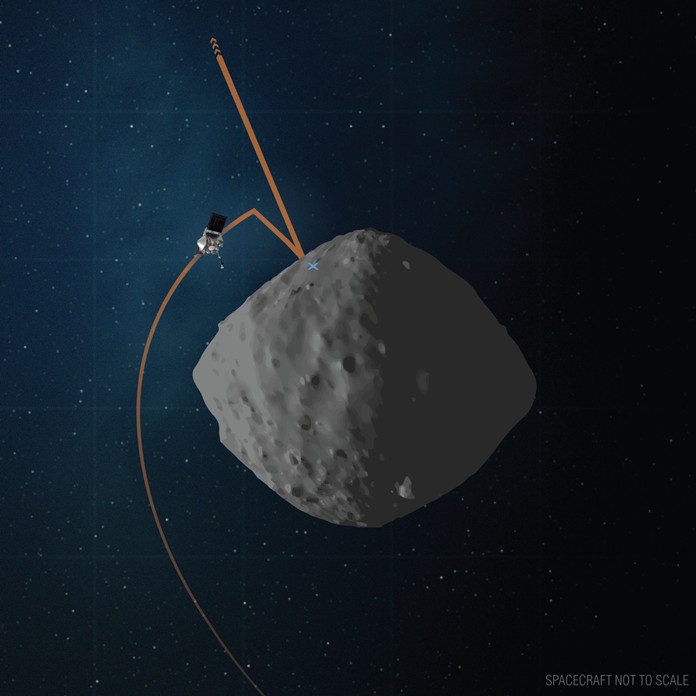
NASA’s first asteroid sampling spacecraft is making final preparations to grab a sample from asteroid Bennu’s surface. Next week, the OSIRIS-REx mission will conduct a second rehearsal of its touchdown sequence, practicing the sample collection activities one last time before touching down on Bennu this fall.
On Aug. 11, the mission was scheduled to perform its “Matchpoint” rehearsal – the second practice run of the Touch-and-Go (TAG) sample collection event. The rehearsal will be similar to the Apr. 14 “Checkpoint” rehearsal, which practiced the first two maneuvers of the descent, but this time the spacecraft will add a third maneuver, called the Matchpoint burn, and fly even closer to sample site Nightingale – reaching an altitude of approximately 131 ft (40 m) – before backing away from the asteroid.
This second rehearsal will be the first time the spacecraft executes the Matchpoint maneuver to then fly in tandem with Bennu’s rotation. The rehearsal also gives the team a chance to become more familiar navigating the spacecraft through all of the descent maneuvers, while verifying that the spacecraft’s imaging, navigation and ranging systems operate as expected during the event.
During the descent, the spacecraft fires its thrusters three separate times to make its way down to the asteroid’s surface. The spacecraft will travel at an average speed of around 0.2 mph (0.3 kph) during the approximately four-hour excursion. Matchpoint rehearsal begins with OSIRIS-REx firing its thrusters to leave its 0.5-mile (870-m) safe-home orbit. The spacecraft then extends its robotic sampling arm – the Touch-And-Go Sample Acquisition Mechanism (TAGSAM) – from its folded, parked position out to the sample collection configuration. Immediately following, the spacecraft rotates to begin collecting navigation images for the Natural Feature Tracking (NFT) guidance system. NFT allows OSIRIS-REx to autonomously navigate to Bennu’s surface by comparing an onboard image catalog with the real-time navigation images taken during descent. As the spacecraft approaches the surface, the NFT system updates the spacecraft’s predicted point of contact depending on OSIRIS-REx’s position in relation to Bennu’s landmarks.
The spacecraft’s two solar panels then move into a “Y-wing” configuration that safely positions them up and away from the asteroid’s surface. This configuration also places the spacecraft’s center of gravity directly over the TAGSAM collector head, which is the only part of the spacecraft that will contact Bennu’s surface during the sample collection event.
When OSIRIS-REx reaches an altitude of approximately 410 ft (125 m), it performs the Checkpoint burn and descends more steeply toward Bennu’s surface for another eight minutes. At approximately 164 ft (50 m) above the asteroid, the spacecraft fires its thrusters a third time for the Matchpoint burn. This maneuver slows the spacecraft’s rate of descent and adjusts its trajectory to match Bennu’s rotation as the spacecraft makes final corrections to target the touchdown spot. OSIRIS-REx will continue capturing images of Bennu’s landmarks for the NFT system to update the spacecraft’s trajectory for another three minutes of descent. This brings OSIRIS-REx to its targeted destination around 131 ft (40 m) from Bennu – the closest it has ever been to the asteroid. With the rehearsal complete, the spacecraft executes a back-away burn, returns its solar panels to their original position and reconfigures the TAGSAM arm back to the parked position.
During the rehearsal, the one-way light time for signals to travel between Earth and the spacecraft will be approximately 16 minutes, which prevents the live commanding of flight activities from the ground. So prior to the rehearsal’s start, the OSIRIS-REx team will uplink all of the event’s commands to the spacecraft, allowing OSIRIS-REx to perform the rehearsal sequence autonomously after the GO command is given. Also during the event, the spacecraft’s low gain antenna will be its only antenna pointing toward Earth, transmitting data at the very slow rate of 40 bits per second. So while the OSIRIS-REx team will be able to monitor the spacecraft’s vital signs, the images and science data collected during the event won’t be downlinked until the rehearsal is complete. The team will experience these same circumstances during the actual TAG event in October.
Following Matchpoint rehearsal, the OSIRIS-REx team will verify the flight system’s performance during the descent, including that the Matchpoint burn accurately adjusted the spacecraft’s descent trajectory for its touchdown on Bennu. Once the mission team determines that OSIRIS-REx operated as expected, they will command the spacecraft to return to its safe-home orbit around Bennu.
The mission team has spent the last several months preparing for the Matchpoint rehearsal while maximizing remote work as part of its COVID-19 response. On the day of rehearsal, a limited number of personnel will monitor the spacecraft from Lockheed Martin Space’s facility, taking appropriate safety precautions, while the rest of the team performs their roles remotely. The mission implemented a similar protocol during the Checkpoint rehearsal in April.
On Oct. 20, the spacecraft will travel all the way to the asteroid’s surface during its first sample collection attempt. During this event, OSIRIS-REx’s sampling mechanism will touch Bennu’s surface for approximately five seconds, fire a charge of pressurized nitrogen to disturb the surface and collect a sample before the spacecraft backs away. The spacecraft is scheduled to return the sample to Earth on Sept. 24, 2023.
NASA’s Goddard Space Flight Center in Greenbelt, Maryland provides overall mission management, systems engineering, and the safety and mission assurance for OSIRIS-REx. Dante Lauretta of the University of Arizona, Tucson, is the principal investigator, and the University of Arizona also leads the science team and the mission’s science observation planning and data processing. Lockheed Martin Space in Denver built the spacecraft and is providing flight operations. Goddard and KinetX Aerospace are responsible for navigating the OSIRIS-REx spacecraft. OSIRIS-REx is the third mission in NASA’s New Frontiers Program, which is managed by NASA’s Marshall Space Flight Center in Huntsville, Alabama, for the agency’s Science Mission Directorate in Washington.
 |
 |
 |





